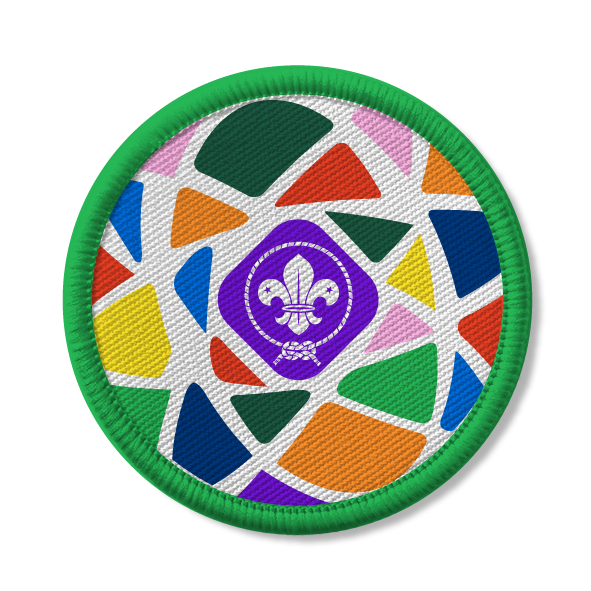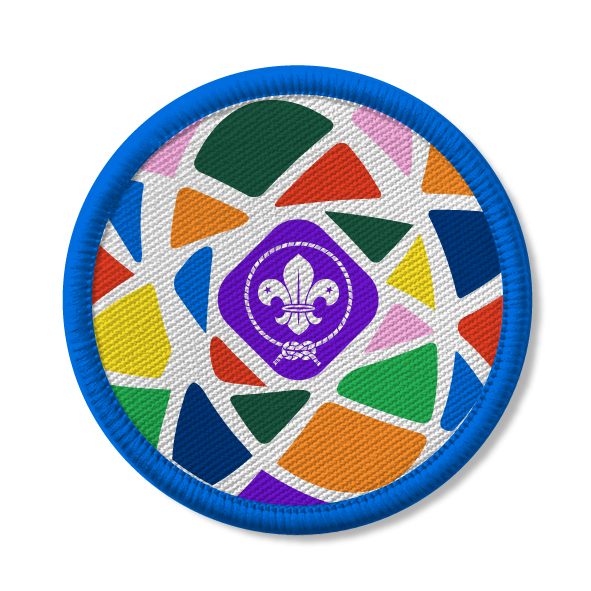
Make shrinking plastic keyrings
You’ll need
- Different types of plastic that would be recycled, such as yoghurt tubs, milk bottles, fruit containers and so on
- Hole Punch
- Permanent markers
- Scissors
- Plastic recycling symbol identification sheet.
- String
- Baking tray and greaseproof paper
- Personal protective equipment, such as heatproof gloves
- First aid kit, including for burns
- Oven or heat gun
Before you begin
- Use the safety checklist to help you plan and risk assess your activity. There's also more guidance to help you carry out your risk assessment, including examples.
- Make sure all young people and adults involved in the activity know how to take part safely.
- Make sure you’ll have enough adult helpers. You may need some parents and carers to help.
Planning and setting up this activity
- This activity involves using lots of different types of plastics, which you could ask people to bring in from home. There may be for lots of reasons, such as living situations or costs. You should consider bringing some spare plastics for people to use.
- There are seven different categories of plastics in the Resin Identification Code (RIC). Make sure to have plastics from all these categories. We’ve included some examples on this page for each category.
- Only use hard, brittle polystyrene (number 6) plastics for this activity. Any other plastics won’t work and may be dangerous. Rigid, hard and clear polystyrene containers, such as those used in supermarkets for fruit or bakery snacks, work well.
The Resin Identification Codes are the little numbers you see on the bottom of some plastic bottles and containers. These numbers were created in the 1980s to help people sort different types of plastic. By sorting plastics correctly, manufacturers can make sure they use the right kind of plastic when making new products, and recycling centres can properly recycle old plastics.
Here’s what the numbers mean:
- Polyethylene Terephthalate (PET). It’s widely recycled.
- High-Density Polyethylene (HDPE). It’s widely recycled.
- Polyvinyl Chloride (PVC). It’s not easily recyclable.
- Low-Density Polyethylene (LDPE). It can be recycled at specialist points
- Polypropylene (PP). It’s widely recycled.
- Polystyrene (PS) or Expanded Polystyrene (EPS). This comes in two forms. It can either be foam, also known as expanded polystyrene, and rigid, solid plastic. Both types have different properties and purposes. It’s not easily recyclable.
- Other. This is plastic is made from something else or a mix of different plastics, such as bioplastics (which are made from plants), plastic-coated paper or certain kinds of packaging, such crisp wrappers. It can be recycled at specialist points.
Polyethylene Terephthalate (PET): single-use bottles, plastic jars, combs, bottles, cooking oil containers and milk bottles
High-Density Polyethylene (HDPE): shampoo bottles, washing up liquid bottles, ice cream containers, yogurt tubs, cereal box liners, hand soap containers, some shopping bags, flowerpots and bottle caps
Polyvinyl Chloride (PVC): fruit trays, plastic bank or ID cards, rain gutters, garden hose, baby teething rings, tablecloths, shower curtains and children’s toys, clingfilm and cosmetic containers
Low-Density Polyethylene (LDPE): bubble wrap, sandwich bags, coatings for cartons, plastic shopping bags, plastic bags for bread and frozen food, rubbish bags, squeeze bottles and clingfilm
Polypropylene (PP): straws, nappies, buckets, yogurt pots, condiment bottles, lunchboxes, butter tubs, bottle caps, clothes hangers, cups, juice bottles, microwavable meal dishes and dip tubs
Polystyrene (PS) or Expanded Polystyrene (EPS): Expanded polystyrene (EPS) is often used for takeaway boxes, postage packaging and foam cups. Rigid polystyrene is often used for CD and DVD cases, food packaging, disposable cutlery and pens.
Other: This is a miscellaneous category that applies to items, such as bioplastics, large reuseable water bottles, DVDs, baby bottles, watercooler bottles, computer keyboards and CD cases.
Plastic pile races
- Gather everyone together and explain that you’re going to be learning about recycling different types of plastic, then making a shrinking plastic keyring.
- Place all the plastic items in the middle of the space.
- Tell everyone that only some plastics can be recycled. Ask everyone how to find out if plastic items can be recycled.
- Explain that there are seven different categories of plastics. All plastic has a number on it, between one and seven, to help us identify the plastic that’s been used to make it. This is known as the Resin Identification Code system (RIC) and helps waste facilities to sort plastics to be thrown away or recycled.
- Divide everyone into seven teams. Each team should be given a different number category of plastic to collect. Make sure everyone’s spaced out equally from each other and the plastic pile.
- When everyone’s ready, shout 'go'. The first person from each team should go to the pile of plastics in the middle and find a plastic item that has their number on it. They should then take it back to their group and the next person can go.
- After a set amount of time, such as three minutes, shout ‘stop’ and see who has collected the most plastic.
- Ask each group to look at the items in their pile and see if there’s any specific products or uses their plastic has. For example, it may be used to make lots of bottles, plastic bags, packaging or toiletries.
- Tell everyone that categories 1 and 2 are widely recycled, 3 and 6 are rarely recycled, and categories 4, 5 and 7 can sometimes be recycled, depending on where you live. Ask everyone what they think about how easily the items in their categories can be recycled, what problems it may cause and any ideas they have for how to help reduce the plastic going to landfill.
- Ask everyone, except for those with number 6 plastics, to put their plastic pile to one side of the space, then gather in a circle.
Make your keyrings
- Explain that polystyrene (PS) or number 6 plastic comes in two different forms. It can either be foam, also known as expanded polystyrene (EPS), and rigid, solid plastic.
- Ask the group who had this category of plastic to remove any of the expanded or foam polystyrene. It can be put to one side of the space.
- Tell everyone that we’re going to use rigid, solid polystyrene plastic in this activity. This plastic shrinks when heated, so we can use it to make keyrings. We can’t use any other form of plastic to do this, as they won’t work and it may be dangerous.
- Tell everyone that they’re going to take some rigid polystyrene plastic and carefully cut out a shape using scissors, being careful of any sharp edges. The flat bottoms of fruit or pastry containers works well for this.
- Everyone should use a hole punch to make a hole in their plastic sheet. This is for the keyring loop to go through. Next, they can use felt tips and permanent markers to draw on the plastic to design a keyring. Remember, the plastic will shrink, so any writing or designs need to be large, so encourage people to fill up the whole space.
- Preheat the oven to 160 degrees Celsius. Alternatively, young people could take the keyrings home to shrink them if guidance is given to parents and carers.
- Line a flat baking sheet with baking or greaseproof paper, then place the keyrings onto the baking sheet.
- Using heatproof gloves, place the tray in a preheated oven for two to five minutes, or until the plastic stops shrinking.
- After two to five minutes, use heatproof gloves to remove the baking tray from the oven and place it on a heatproof, stable and flat surface to cool down, out of reach of young people.
- Once cooled, everyone can collect their keyrings. You could use string, ribbon or metal loops to make the keyrings, using the hole-punched hole.
Reflection
This activity was all about learning about how plastic can be reused, recycled or disposed of correctly. Do you currently recycle plastic when you can? Did you know that there were so many different categories? Have you ever noticed the symbol or number before today?
We learned about what plastics could and couldn’t be recycled. What did you think about what plastics could and couldn’t be recycled? You may have been surprised that some commons items can’t be recycled. What can we do to help? We can try to find reuseable items, rather than single use items, such as paper or metal straws, to help stop plastics that can’t be recycled being thrown away. We also reused a plastic that couldn’t be recycled (number 6, rigid polystyrene) to make something new, keyrings. Had anyone made these keyrings before? Did they find the process easy or challenging? Why might this be a good way to reuse plastic? Are there any ways we could reuse any of the other items?
Safety
All activities must be safely managed. You must complete a thorough risk assessment and take appropriate steps to reduce risk. Use the safety checklist to help you plan and risk assess your activity. Always get approval for the activity, and have suitable supervision and an InTouch process.
- Glue and solvents
Always supervise young people appropriately when they’re using glue and solvent products. Make sure there’s plenty of ventilation. Be aware of any medical conditions that could be affected by glue or solvent use and make adjustments as needed.
- Scissors
Supervise young people appropriately when they’re using scissors. Store all sharp objects securely, out of the reach of young people.
- Sharp objects
Teach young people how to use sharp objects safely. Supervise them appropriately throughout. Store all sharp objects securely, out of the reach of young people.
- Rubbish and recycling
All items should be clean and suitable for this activity.
- Hot tools
Tools, such as irons and glue guns, produce a lot of heat. Never touch the hot metal parts. Use them under adult supervision and on a suitable surface, protecting it if necessary. Never leave hot tools unattended and be careful near combustible materials such as wood, textiles, or paper. Make sure there’s a fire extinguisher and a first aid kit (with items to treat burns) nearby. Always follow the manufacturer’s instructions for proper use. You may need to use gloves and safety goggles with glue guns.
- To make this activity easier, you could provide the pre-cut plastic shapes for people to use to make their keyrings. To make this activity harder, for the plastic sorting part of the activity, you could include items that we may not typically think about being or containing plastic, such as polyester clothing, face scrubs with tiny plastic beads, fruit netting, acrylic wools, or fake or faux leather.
- You could add add colour code to items to aid young people who may struggle to see the plastic identification symbols. You could also print out a larger-print version of the symbols and stick them on the items.
- Check for allergies when using foods in activities (even if not for consumption), including their packaging. It’s still important to risk assess these activities and check for any ingredients, allergens or cross-contamination, just as we would if we were eating the food. You may need to ask people to avoid bringing certain items, ask people to wash their hands after touching food packaging, or avoid using some items, such as food packaging.
All Scout activities should be inclusive and accessible.
Try some of our other activities that reuse plastic, such as rolling bowling.

